|

Introduction
To set the stage here, I should begin by saying that I
routinely only use FS9 and that almost all my flying is
in JF’s Cargo Pilot. I use the JF Traffic 2005 program
with both of the Military PlusPaks. My normal AC is the
Captain Sim C-130, which takes me up into the flight
levels on all but the shortest flights. My traffic
slider is nearly always at 100% so traffic is
realistically dense most of the time (…sometimes in both
senses of the word). The reader should bear in mind that
this review is written from within those perspectives.
About Radar Contact
This version of RC is FSX compatible. I do have both FS9
and FSX on my PC so I selected the dual-install option
for RC. My purchase was the CD version, which comes on a
single CD. The installed size is about 1.4 GB for each
version of FS. RC is also downloadable at the same
price, $44. It is shipped from Georgia in the US. The
site states that purchasers should allow 2 to 4 weeks
for delivery – mine came in three days, but then I’m
less than 400 miles from them.
For the initial run the program requires a startup key
that is not part of the delivered package. The new user
must send an e-mail and await a reply containing the
key. This does not appear to be an automated process,
but I did have mine within about three hours, along with
a friendly message, e-mail addresses and a link to the
Radar Contact Commercial Support forum in AVSIM.
The load time from the CD is quite lengthy, perhaps on
the order of 20 minutes, though remember that I had
selected a dual install for both versions of FS. I noted
many, many WAV files being loaded. Audio takes some
time. If you’re the type who likes to rip the CD out of
the package with the intent to be flying three minutes
later, you’d best take a deep breath and relax. Between
the install time and getting the key, things are not
going to go quite that quickly. Have patience - it will
be rewarded!
The manual is prodigious, a 294 page pdf file. It is
available on-line so prospective buyers can check the
product out in detail before making a decision. If you
purchase RC, I strongly advise spending some time with
the manual while waiting for your CD to arrive. This is
not the kind of program you’ll want to learn by Braille
- you can probably make it work, but you’ll miss about
80% of what it can do. Read the manual and when you can,
fly the eight tutorial flights detailed there.
Using Radar Contact
I’ve been chafing under FS ATC for some time and have
been on the lookout for something better. At the
recommendation of a very good on-line flight-simming
friend I looked into RC and decided to purchase it. I
have made a half dozen or so flights under RC now, a
couple over 1,200 NM and at night. I can say with some
confidence at this point that RC is better. It’s not
just a little better – it’s in a different universe. If
you are a serious IFR simmer, you will be very, very
impressed with the great leap of capability over what FS
offers. Is it perfect? No, but it’s very, very good.
Radar Contact loads last. The process is to start FS
then Alt-Tab out to kick off RC. RC opens to a menu
screen where pre-flight options are handled, including
selection of your previously saved flight plan from any
of a wide variety of popular flight planners. The scope
of this review will not permit a lot of detail here, but
suffice to say that there are many configurable options
for the IFR flyer. Alternate airports (up to two) can be
designated; voices for pilots, controllers and co-pilot
can be chosen from a much larger selection than provided
by FS or T2005; various restrictions can be selected or
de-selected, and much, much more. After setting up the
pre-flight options there’s another button to “Start RC”.
In effect you start it twice.
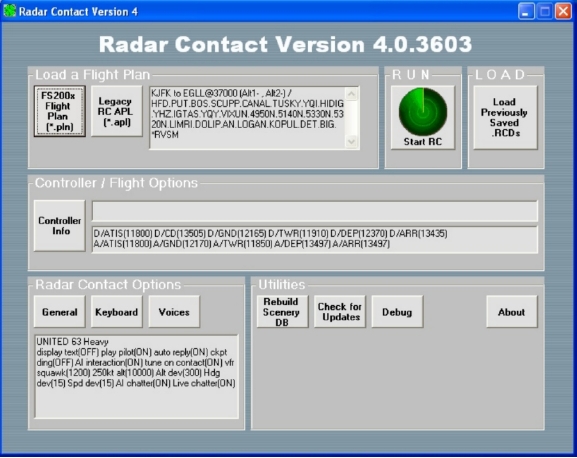
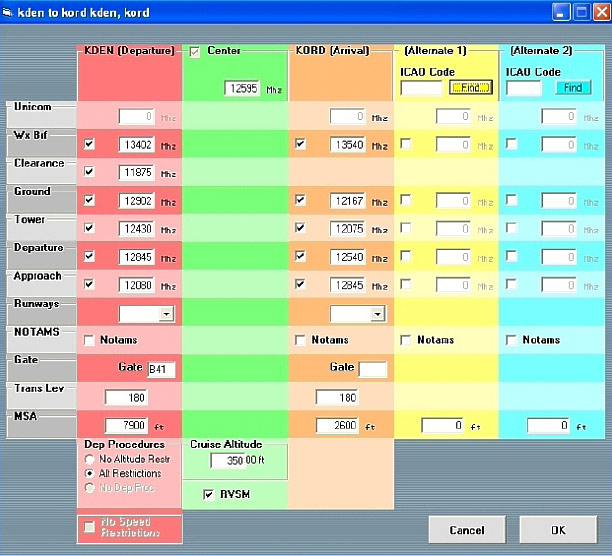
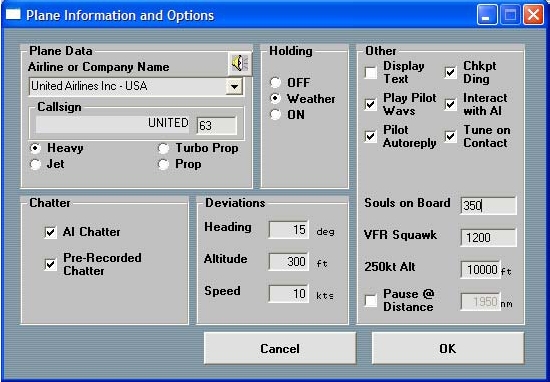
The
cockpit interface is quite similar to FS ATC. A
transparent window appears with menu choices selected
mainly by the keyboard number keys. The window is
re-sizeable and re-locatable. The default text is red,
perhaps not the best choice. I’ve read on the RC support
forum that there is a config file with variables that
can be edited, providing different text colours. I have
not pursued that yet. In actual use, the red text has
not caused any serious difficulty.

I had to
spend some time looking for all the other things to shut
off in FS and other add-ons. There were things in T2005
and it’s minion, AISmooth that had to be deselected, and
some things in the FS menus too. None of these caused
any errors, but were just competing voices, windows,
etc. that were no longer required.
Do not be mislead by the apparent similarity of
interface between the FS and RC flavours of ATC. It’s
what lies behind the menu choices that makes the
difference. The simplicity of the RC interface belies
the power and complexity of what is beneath. RC takes
you into depths of simulated reality that are beyond
what you can imagine if you’ve only used FS ATC.
Co-Pilot Assistance
This is so useful it deserves a specific description.
With key-presses, you can give the co-pilot the radios,
the aircraft or both. I used this with caution but it
works very well and I’ve come to trust it. Bathroom
breaks no longer involve the “P” key.
When handling comms, the co-pilot acknowledges all ATC
communications, changing frequencies and squawks as
directed. When flying he follows the flight plan, tuning
the NAV1 radio and adjusting the OBI as needed. He is
not so perfect as to seem robotic, but is good enough to
be trusted. I noticed that he does not use the pre-set
register of COM1 but somehow puts the new frequency
directly into the active frequency window – unrealistic,
but effective. With the NAV radios, he only uses NAV1,
tuning each new station as it becomes available, some
how knowing when that is.
The co-pilot is only available in certain phases of the
flight; he must have a strong union. He will not take
off – you must have shifted to departure before bringing
him into play. He will not fly an approach or land.
Anything in between, however, is apparently not in
violation of his contract and is fair game.
Coupled with another feature, called pause at distance,
a new set of possibilities becomes viable for those
flying long boring flight legs. RC allows you to set a
“pause at distance” number in the pre-flight screen. At
that distance from the arrival airport, RC pauses the
sim. The implication here is that you can begin your
flight, turn over the AC and comms to the co-pilot and
come back the next morning to fly the descent and
landing. I can see the VA pilots lining up already.
There are a few things about the co-pilot feature that
could be improved in terms of realism, but as it stands
it is effective, usable and believable.
What’s
New And Good
-
Holds
are available! You can have them always, never or
sometimes. This takes care of my biggest beef with
FS ATC.
-
There
is a concept in RC called NOTAMs. It’s not what you
think. It provides ATC latitude for a pilot
controlled departure (or arrival) where terrain
avoidance, noise abatement measures, departure
procedures or other limitations that ATC can’t or
don’t know about are in play. Once beyond those and
on course, you let ATC know that you can accept
their guidance and you’re off on your flight plan.
It’s a great idea and well implemented, but it seems
like a dumb name for it.
-
During
departure you are sometimes cleared direct to your
first navaid before you’ve made your way to the
flight plan course line.
-
New
squawks are sometimes issued while in flight. In
hundreds of hours of FS IFR I have never seen that
happen before trying RC.
-
There
is an option to “Ding” when passing a flight plan
checkpoint. What a great idea!
-
RC
seems to handle busy departure queues much better
than FS alone. It makes more aggressive use of
position-and-hold and seems to give a higher
priority to you, the non-AI aircraft.
-
“Aircraft calling center, say again…”. They didn’t
have to put this in but they did. It’s random. I’ve
only heard it once or twice, but it’s one of many
small touches that add realism and believability.
-
Not
once have I heard “Report traffic in sight” or
“…have the traffic”.
-
RC
climb clearances are more timely. You are typically
cleared to the next step up a thousand feet or more
before reaching the current assigned altitude, vice
the brinksmanship that is common in FS ATC.
-
I have
not been batted like a tennis ball between a pair of
controllers – not once.
-
There
have been none of the dreaded “sawtooth” vectors to
final.
-
When
getting Wx or Clearance at an uncontrolled field,
the audio simulates placing a telephone call –
another of those small touches of reality.
-
There
is a menu option to request clearance direct to a
future checkpoint. I’ve used this several times to
“cut the corner” when the flight plan has a radical
dogleg, saving time and distance.
-
Traffic alert responses only require acknowledging;
you don’t have to say whether you see the traffic or
not.
-
…and
much, much more!
What’s New And Not So Good
-
The
manual is out of date in places. Version 4.3 is new
and perhaps an update is in progress. The developer
is working on version 5 already. Hopefully the
manual is part of that.
-
RC
does not issue specific taxiway routing
instructions. It’s more like, “Taxi to and hold
short of runway nn.” Have an airport diagram handy.
-
There
is no longer any progressive taxi assistance
available.
-
The
voice messages are more rough, choppy and patched
than those of FS ATC. It’s obvious in both programs
that the messages are created by linking audio files
of the individual elements, however RC’s are not as
smooth as the MS ones. On the positive side, the
number of voices and the variety and content of the
messages is far beyond what we’ve been used to. In
no case are the messages garbled or difficult to
understand.
-
At a
field where there were some Air Force types in the
queue ahead of me, ATC referred to some as “Air
Force (number)” and to others as “Alpha India Romeo
Foxtrot Oscar Romeo Charlie Echo (number)”. I’ve
heard similar things enroute with certain airline
names with ATC spelling out the name phonetically.
-
If
communication with AI is in progress and you switch
frequencies, the in-progress message plays out to
the end rather than being cut off. Ditto when
pausing.
-
You
cannot use the 1 and 2 suffixes for pushback to turn
the AC left or right. The numeric key-presses are
intercepted as RC menu selections. This may apply to
other things that use the number keys as well.
(doors, engine selections?)
ADDENDUM- It turns out that on the initial RC screen
there's a button labelled "Keyboard". It's a utility
that allows you to re-map most of the keys used by
RC to something else. The suggestion I saw on the RC
commercial support forum on AVSIM suggests
re-mapping "1" and "2" to Ctrl-Shft 1 and Ctrl-Shft
2 respectively. RC's menu would recognize those and
that would leave 1 and 2 free to be used by the MS
commands that expect them. That's one problem put to
bed!
-
AI
chatter is sometimes very staccato without any hint
of a delay between the ATC voice and the AC voice or
vice versa. Separating them with a short pause and a
microphone “pop” would improve them.
-
There
doesn’t seem to be any allowance for “pop-up”
clearances filed in the air. If so I haven’t found
it.
-
Some
company call signs do not seem to be in the RC
vocabulary, e.g. I heard flights referred to as
“Mike (number)”. When I looked up the number in the
T2005 traffic editor, they were “Merican”. A
capability to add and index your own WAV files for
this would be good, though matching the voices and
accents would be problematic.
What’s New
or Different – You Decide If It’s Better Or Worse
-
At a
key-press you can leave the frequency to check
weather with ATC’s blessing. It’s entirely
automated. You don’t have to touch the radio or even
know the frequency, nor do you need to remember the
centre frequency to come back to. It all just
happens and is unrealistically easy. To me it felt
“gamey”, unrealistic and contrived. This is a good
and needed feature, but begs for improved
implementation.
-
There’s much less (though not zero) AI chatter on
the frequencies than under FS ATC with the same
traffic settings.
-
The
threshold for RC issuing traffic alerts seems
considerably higher than for native FS. Relatively
few traffic alerts are heard.
-
There
seem to be fewer enroute frequency changes within a
Centre's area of responsibility.
-
Squawk
codes must be manually set in the transponder
(unless co-pilot has the comms). I rate this a plus
due to reality – you may not.
Specific
Incidents
-
RC
issued a traffic alert for another AC that was level
at my altitude on a reciprocal course at 14 miles. I
appreciated the alert but wonder why ATC had him
there. AI traffic sometimes has a mind of its own.
-
I flew
a 75 mile downwind, never receiving an instruction
to turn to base. RC just forgot about me. It
happened on one flight only, and I’m not sure what
caused it.
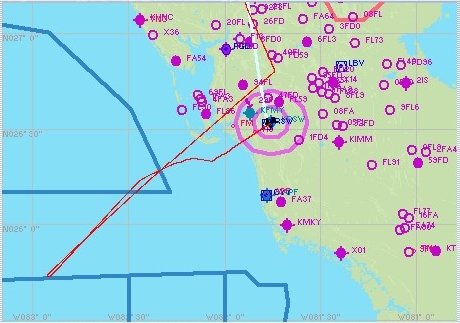
-
Close
call @ 35,000 ft, at night - AC crossed 0.3 NM in
front of me, 90 degree tracks, same altitude. I saw
him coming on the radar, and was ready to take a
screen shot (see below) but no traffic alert was
issued by RC. I wasn’t sure if the screen shot would
be a near miss or an aluminium shower, but it was
going to be a memorable picture in either case. When
you can see individual windows, he’s too close. (The
white dot on the nose of the radar screen aircraft
icon is the target blip.)
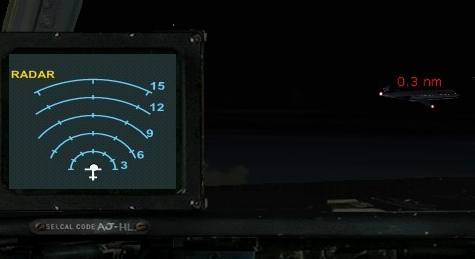
Ending on
a positive note, I already rank Radar Contact as one of
the very best FS add-ons I’ve purchased. Like many of
you, I have a shelf full that I found disappointing and
don’t even use. This one will not let you down if you
enjoy flying IFR. The realism is up by an order of
magnitude and there’s also much in the way of reduced
frustration and fewer delays. The on-line support forum
seems lively and useful, and is regularly serviced by
the developer, not just by users. I’ve only scratched
the surface of the capabilities in this review. There is
a great deal more in this package that I haven’t
mentioned, and very likely some pearls that I haven’t
found yet.
I contacted the publisher after purchasing the product
and after deciding to write a review. I am not beholden
to them for a free review copy. My purpose was to
solicit from them those things that they believed
important enough to be included in the review. Though I
didn’t get a direct answer to that question, these are
what I did glean from the response:
If you
like IFR and the Microsoft ATC isn’t floating your boat,
give this one serious consideration.
|